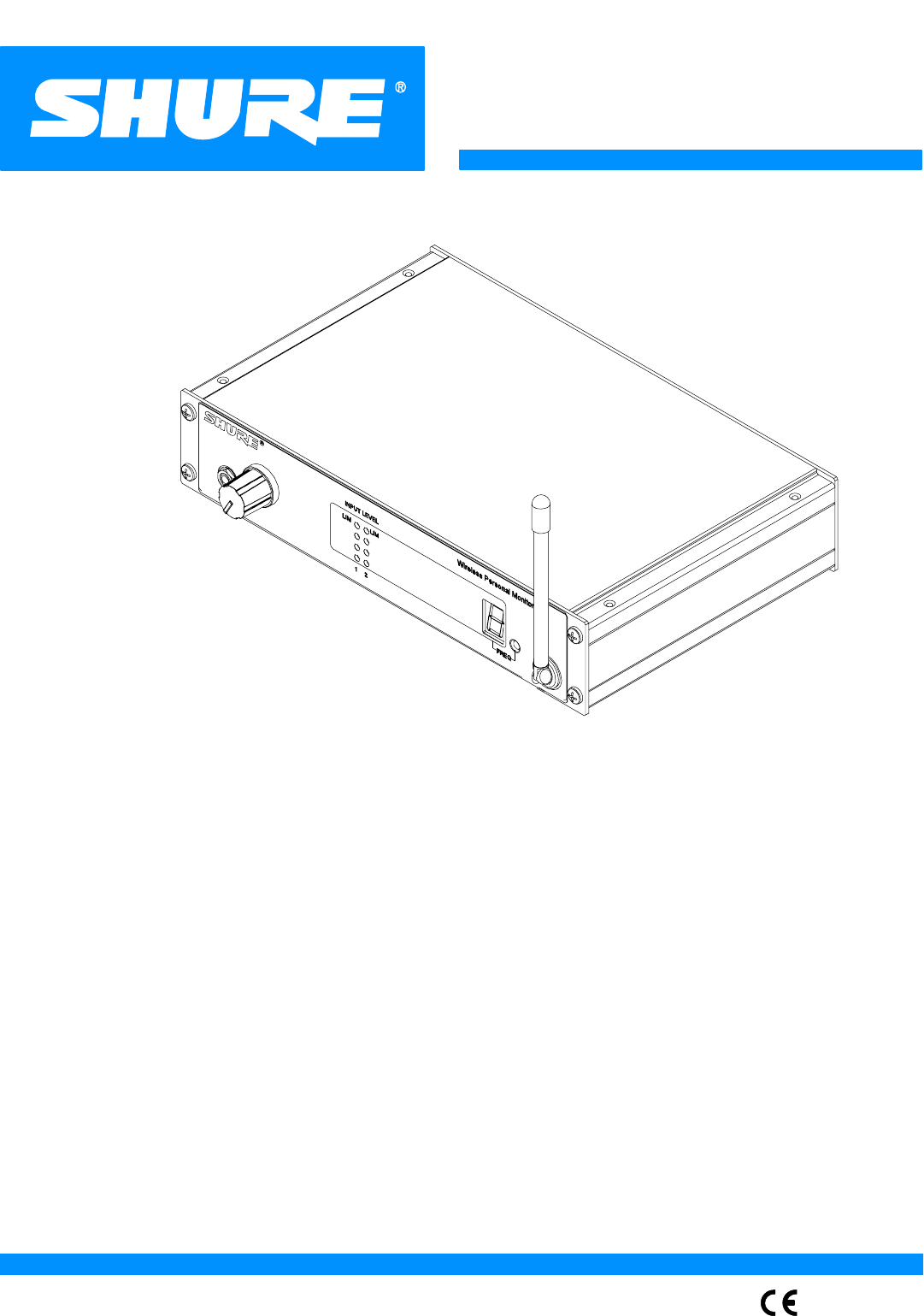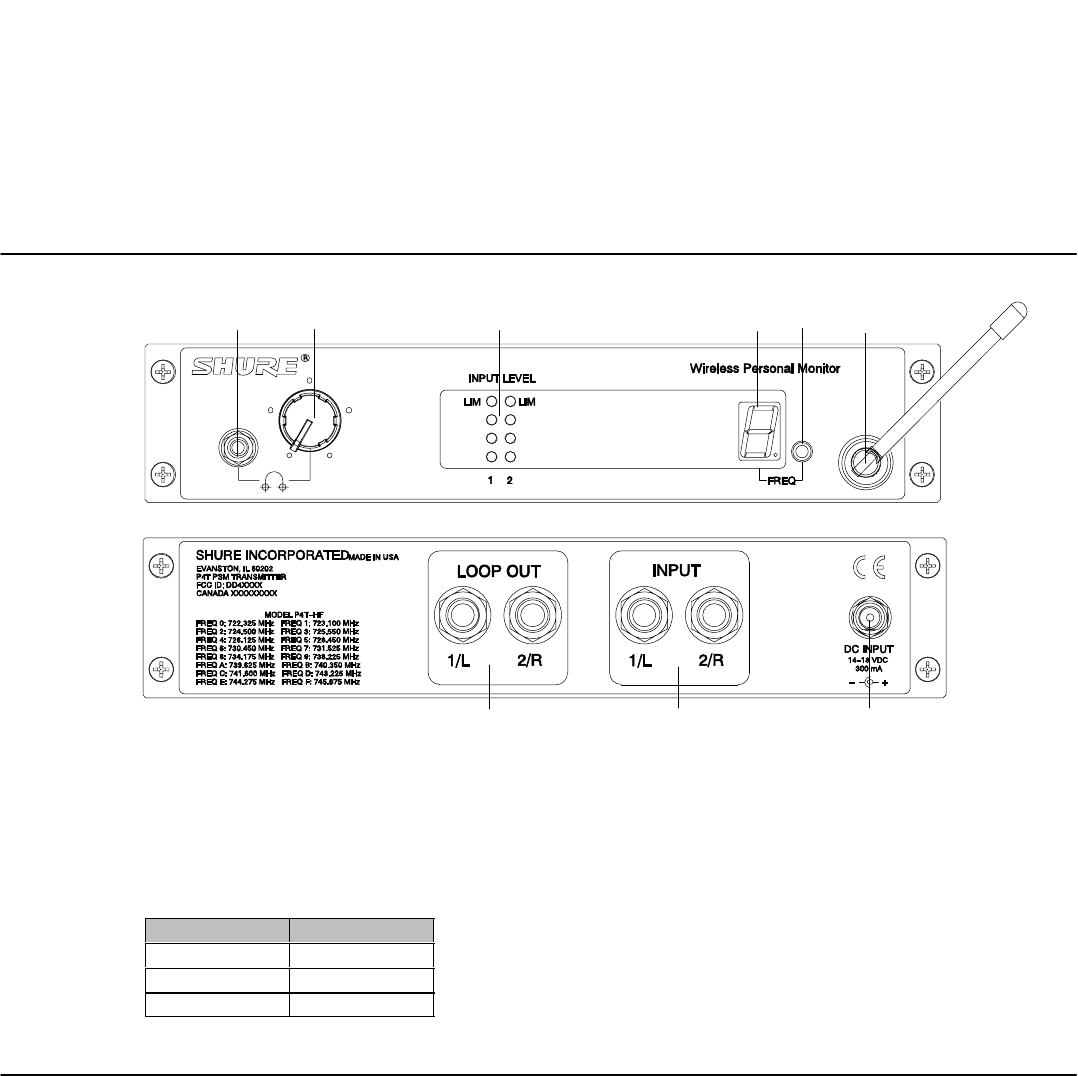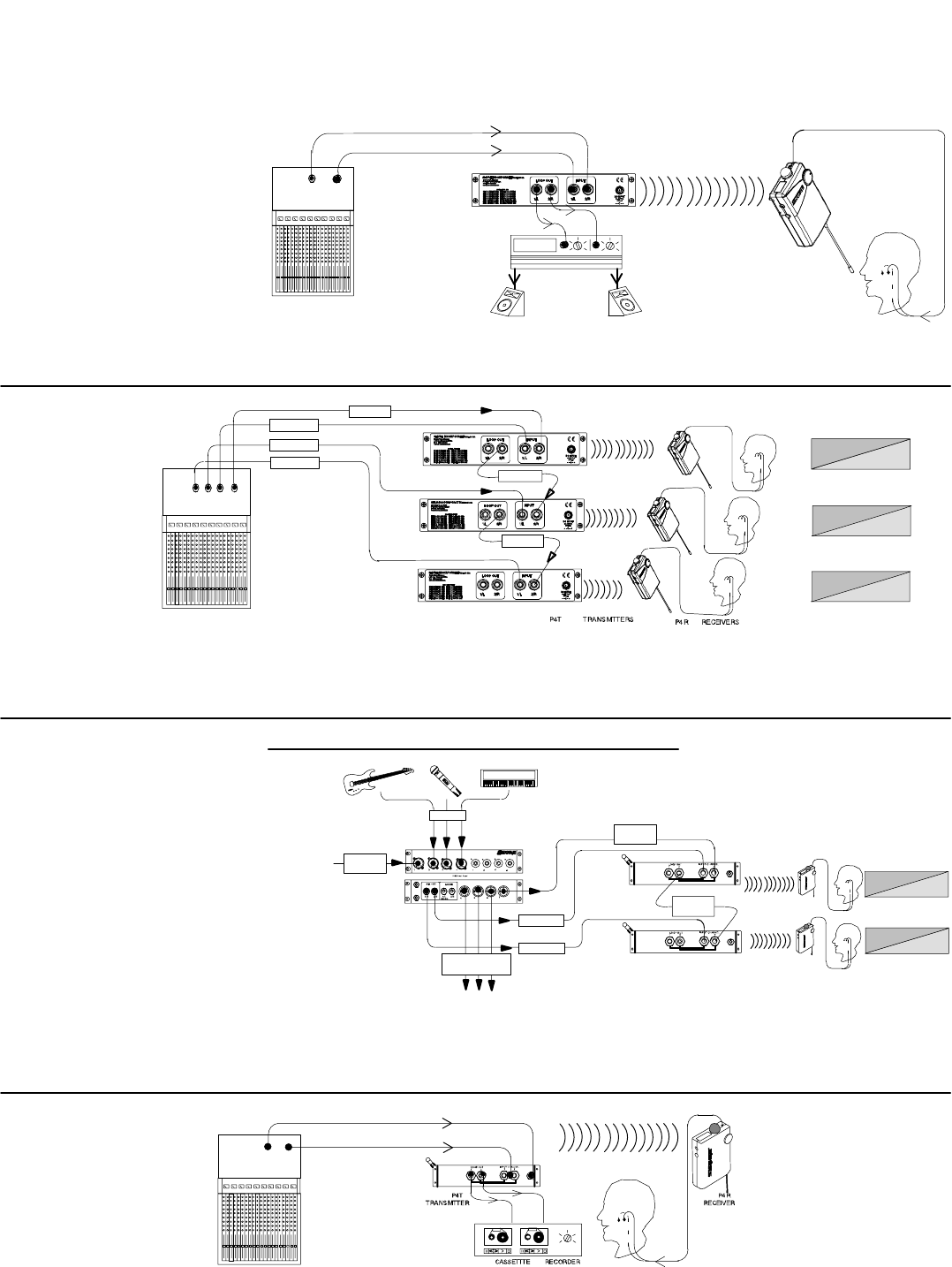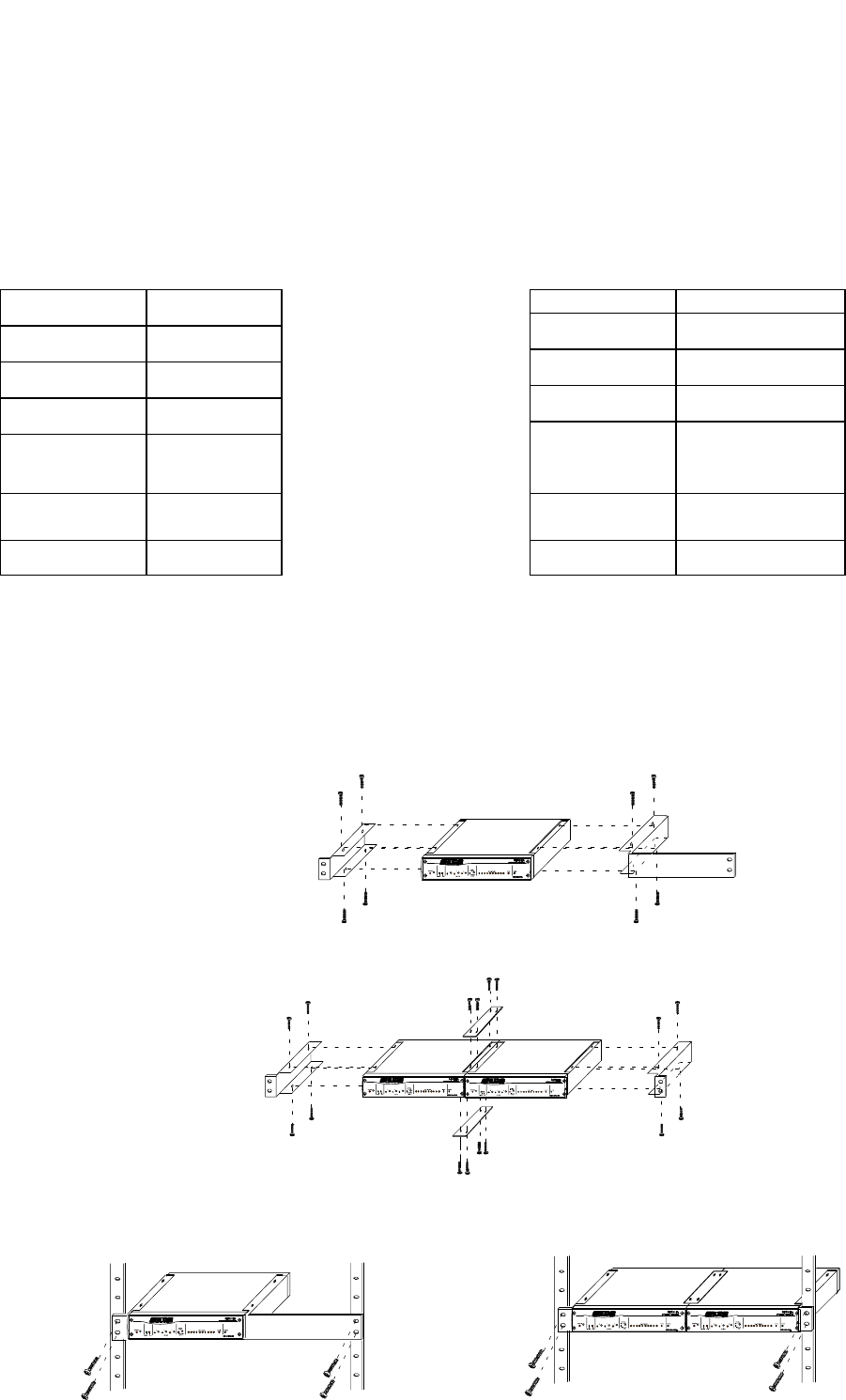Shure orporated P4T Lo Power Base Station Transmitter User Manual P4Ten2
Shure Incorporated Lo Power Base Station Transmitter P4Ten2
P4T User Guide

P4T Transmitter
Shure Incorporated
222 Hartrey Avenue
Evanston IL 60202-3696 U.S.A.
Model P4T Transmitter User’s Guide
27A8712 (SC)
E1999, Shure Incorporated Printed in U.S.A.

WARNING!
USING THIS SYSTEM AT EXCESSIVE VOLUMES CAN CAUSE PERMANENT HEARING DAMAGE.
USE AS LOW A VOLUME AS POSSIBLE.
In order to use this system safely, avoid prolonged listening at excessive sound pressure levels. Please use the following
guidelines established by the Occupational Safety Health Administration (OSHA) on maximum time exposure to sound
pressure levels before hearing damage occurs. 90 dB SPL at 8 hours
95 dB SPL at 4 hours
100 dB SPL at 2 hours
105 dB SPL at 1 hour
110 dB SPL at 1/2 hour
115 dB SPL at 15 minutes
120 dB SPL — avoid or damage may occur
It is difficult to measure the exact Sound Pressure Levels (SPL) present at the eardrum in live applications. In addition
to the volume setting on the PSM, the SPL in the ear is affected by ambient sound from floor wedges or other devices.
The isolation provided by the fit of quality earpieces is also an important factor in determining the SPL in the ear.
Here are some general tips to follow in the use of this product to protect your ears from damage:
1. Turn up the volume control only far enough to hear properly.
2. Ringing in the ears may indicate that the gain levels are too high. Try lowering the gain levels.
3. Have your ears checked by an audiologist on a regular basis. If you experience wax buildup in your ears, stop using
the system until an audiologist has examined your ears.
4. Wipe the ear molds with an antiseptic before and after use to avoid infections. Stop using the earphones if they are
causing great discomfort or infection.
This symbol indicates that dangerous voltage constituting a risk of electric shock is present within this unit.
This symbol indicates that there are important operating and maintenance instructions in the literature accompanying
this unit.
FCC Statement. The P4R Receiver complies with part 15 of the FCC rules. Operation is
subject to the following two conditions: (1) this device does not cause harmful interference,
and (2) this device must accept any interference received, including interference that may
cause undesired operation.
Licensing Statement. A user license may be required for operation. Contact the com-
munications authority in your country for more information.
Modifications to Approved Equipment. Changes or modifications not expressly ap-
proved by Shure Brothers Incorporated could affect compliance with telecommunications
standards, thereby voiding the user’s authority to operate this product.

Introduction
Thank you for buying the P4T Transmitter. The P4T is a component in the PSM400 family of wireless personal monitors. When used in conjunction with a P4R
Receiver, it provides the many advantages of an in–ear monitoring system, including:
SImproved Sound Quality - high fidelity without the risk of feedback,
SIncreased Mobility - your mix moves with you,
SPersonal Control - through volume adjustment and MixMode.
This user’s guide covers the use and features of the P4T Transmitter. For further instruction on the use of the PSM400 system, see the PSM400 system user’s
guide, availaible on the web at www.shure.com.
P4T Transmitter Features
123456
789
Front Panel
Back Panel
1. Local Earphone Output Jack (1/8 inch): Connects to E1 or E5
earphones.
2. Local Earphone Level Control: This knob adjusts the volume of
the local earphone jack’s amplifier. Always listen at low levels.
3. Input Level LEDs: Two vertical strings of four LEDs display the
input level of the left and right input channels. The four LEDs on
the left displays the status of the signal from channel 1 and the
four LEDs on the right displays the status of the signal from
channel 2:
LED Signal Status
RED (top) Limiter Active
YELLOW (middle) Nominal Level
GREEN (bottom two) Signal Present
4. Frequency Select LED: This indicates which of the 16 Chan-
nels (0 - 9 and A - F) is selected.
5. Frequency Select Button: This recessed button allows the
transmission channel to be changed. To use, hold down the
button until the desired channel number is displayed in the
LED. Release the button and the number will flash. Quickly
push and release the button again to confirm changes.
6. Front-Mounted Antenna: The units antenna is permanently
attached and break-resistant.
7. Loop Out Jacks: Two 1/4” TRS jacks allow the audio signal to
pass through the transmitter to other devices, such as other
transmitters, tape recorders, or amplifiers.
8. Input Jacks: Two 1/4” TRS Switching Jacks for line level audio
inputs. If only one input is used, the signal will be routed to both
sides of the modulator for Mono operation. If both Jacks are
used, the signals will be transmitted in Stereo/MixMode.
9. 12VDC Locking Connector: Input for PS40 Power Cord.
Set Up and Operation
Follow these directions to set up the P4T for operation.
1. Plug the power cord into the P4T’s 12 VDC locking power connec-
tor. Plug the other end of the power cord into a wall outlet.
2. Connect line level outputs of an audio source into the audio
inputs of the P4T transmitter. Use both of the P4T’s input jacks
for a two-channel source. Use either input jack for a mono
source. The P4T Transmitter will transmit in MixMode/Stereo if
both inputs are used, but will automatically transmit in mono if
only one input is used.
NOTE: All inputs are phantom power protected up to 50 VDC.
3. Select an operating frequency using the Frequency Select Button.
The selected frequency will be displayed in the LED.
IMPORTANT: Never set more than ONE transmitter to the
same operating frequency.
4. Once audio is being transmitted by the P4T, observe the Input
Level LEDs. If the input signal is consistently causing the red
LED to illuminate, decrease the output level of the audio source
until the red LED only flickers occasionally.
5. Set up the P4R receiver as directed in the P4R user’s guide,
making sure that the frequency selected on the receiver
matches the frequency selected on the transmitter.

LOOP Applications
The LOOP OUT L (left) and R (right) outputs allow the signal going through the P4T to be routed to other devices. The LOOP feature of the P4T can be used
for any number of applications. Shown here are only a few examples of how it can be used.
MIXER
Floor Monitor
Amplifier
P4T Transmitter
P4R
Receiver
Running Floor Monitors Through a P4T Transmitter
An audio signal can be sent through the LOOP connectors to an amplifier for an onstage monitor system. When setup this way, the P4R and the onstage monitors
will reproduce the same audio.
MONITOR
MIX
MONITOR
MIX
MIX OUT 1
MIX OUT 2
MONITOR
MIX
MIX OUT 2
SOLO MIX
SOLO MIX
SOLO MIX
BAND MIX
BAND MIX
BAND MIX
Running Multiple PSM Wireless Systems Under MixMode Control
A single mono monitor mix can be sent to multiple P4T transmitters, then independent monitor mixes or direct outputs can be sent to the second channel of each.
This will allow an entire band to hear the same monitor mix, while giving each individual player a separate mix of their own. Each player can then use the balance
control to adjust the levels between their own mix and the main mono monitor mix.
MONITOR
MIX
MIX OUT 1
MIX OUT 2
MONITOR
MIX
NOTE: See the P4M and PSM400 User’s Guides for forther information on this feature.
MONITOR
MIX
MONITOR
MIX
AUDIO IN
AUDIO OUT TO
FRONT-OF-HOUSE
MONITOR
MIX
MIX OUT 1
MIX OUT 2
Running Two PSM Wireless Systems Under MixMode Control From a P4M Mixer
When using the P4T in conjunction with a Shure P4M Mixer, a single mono monitor mix can be sent unaltered to two P4Ts. Each P4T can also receive a seperate
Mix Out signal, providing each P4T with a common monitor mix and a custom mix created by the P4M. The balance control on the P4R receiver is used to adjust
the levels betwen the monitor mix and the P4M mix.
Running a Recording Device Through a P4T Transmitter
If you would like to make a recording of a performance, the LOOP outputs can be connected to the inputs of a tape deck, DAT, or other recording device.

SPECIFICATIONS
RF Output Power
50 mW (+17 dBm) typical conducted (country
dependent)
Modulation Limiter
Internal peak limiter (>10:1 compression)
Antenna
1/4 Wavelength, semi-rigid, PCB Mount
Power Requirements
Table-Top AC Adaptors
P4T: (Input: 120 Vac, 60Hz, 14w; Output: 15 Vdc, 600 mA, 9w)
EP4T: (Input: 230 Vac, 50 Hz/60Hz; Output: 15 Vdc, 600 mA, 9w)
Current
220 mA maximum
Dimensions
219.2 mm X 43.6 mm X 136.5 mm (8.6 in. X 1.7 in. X 5.4 in.)
Net Weight
907.2 g (2 lbs., 0 oz.)
CONNECTORS
P4T Audio Inputs (LEFT/CH.1 and RIGHT/CH.2)
Connector Type: 1/4-inch phone jack
(female) TRS
Configuration: electronically
balanced
Actual
Impedance: XX kΩ
Nominal
Input Level: –XX dBV
(–10 input level)
Maximum
Input Level: +X dBu
(+4 input level)
+XX dBu
(–10 input level)
Pin
Assignments: Tip = hot
ring = cold
sleeve = ground
Phantom Power
Protection? Yes
Up to 60 VDC
P4T L/R LOOP Outputs (IN and OUT)
Connector Type: 1/4-inch jack (female) TRS
Configuration: electronically
balanced
Actual
Impedance: XX kΩ
Nominal
Input Level: –XX dBV
(–10 input level)
Maximum
Input Level: +XX dBu
(+4 input level)
+XX dBu
(–10 input level)
Pin
Assignments: Tip = hot
ring = cold
sleeve = ground
Phantom Power
Protection? Yes
Up to 60 VDC
RACK MOUNTING THE P4T
The P4T features a 1/2-rack chassis specially designed for sturdiness. The sagging and bending
found in most 1/2-rack designs is eliminated — the brackets and straddle bars are designed to ensure that
the units will be installed securely.
WARNING: Do not torque the screws too tightly, or the chassis may be damaged.
Single Unit
Dual-Mounted Units
NOTE: Be sure to use both straddle bars when installing dual units.
Mounting in an Equipment Rack